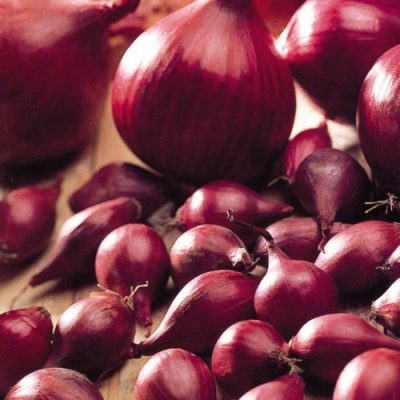
- Name synonyms: Romy
- Year of approval: 2015
- Ripening terms: mid-early
- Bulb weight, g: 90-100
- The form: rounded
- Dry scales: dark red
- Coloring juicy scales: reddish
- Taste: semi-sharp
- Appointment: universal
- Yield: high
Appeared in Russia relatively recently, in 2015, the red onion variety Romy was bred by breeders from the Netherlands for fresh consumption, pickling, processing. In addition to its outstanding taste, it has many other advantages, matures early, and adapts well to difficult climatic conditions.
Description of the variety
The variety is universal, with excellent commercial characteristics. Suitable for long distance transportation, storage. It ripens 100% before harvesting. Can be grown on greenery on a windowsill.
Characteristics of the appearance of plants and bulbs
Romy's heads are round in shape, with an average weight of 90-100 g. Dry scales are colored dark red, almost burgundy. Juicy is also bright enough. There is a reddish tinge on the general white background, there is a silvery coating. The variety is small, there are up to 2 bulbs in the nest.
The rosette of leaves is narrow, neat. The feathers are not too long, on average about 30 cm. Narrow, delicate, with a green color and a slight waxy bloom.
Purpose and taste
Romy has an excellent semi-sharp taste with pronounced sweet notes and juicy pulp. It is good both in salads and in marinades and other dishes. Green feathers also taste good and are rich in vitamins.
Maturation
Medium early variety. Ripens in 75-85 days from the moment of germination, when planted before winter - 2 weeks earlier. Harvesting begins in mid-August.
Yield
When grown industrially, Romy onions yield up to 232-368 c / ha. Refers to high-yielding varieties. At least 3-4 kg of onions are harvested from 1 m2.
Growing regions
Romi is zoned for planting in the central regions of Russia.
Planting dates with seeds, seedlings and seedlings
The variety is recommended for cultivation in a two-year cycle, with the production of turnip from seedlings. In the first year, nigella is sent to the ground, from autumn - at the beginning of October, but it can be repaired in mid-spring. Seeds from podzimnogo sowing in the spring may not sprout due to freezing. In the 2-3 decade of April or early May, the site is planted with sevka.
Growing and care
The preparation of the ridges is carried out in the fall, by digging, introducing organic matter.

Since the onion is an unpretentious and cold-resistant plant, it can be planted both in spring and autumn. It is necessary to properly prepare the planting material, competently prepare the garden bed and determine the timing of planting.

Soil requirements
The best soil for this variety of onions will be well-fertilized sandy loam or loam, loose black soil. Fertility and breathability are very important for bountiful harvests. It is advisable to maintain neutral acidity by adjusting its values with wood ash or other natural remedies.
Spring sowing should be started only after the soil has completely warmed up.Haste will lead to the shooting of the bow, it will not be possible to get heads from it. Sevok should be soaked in advance in a growth stimulator. With the appearance of feathers on the surface, watering is carried out every 3 days, until about mid-June. Every 10 days, the bed is fertilized with urea.

The bow is not as unpretentious as it seems. For good growth, you need fertile soil, quality care and nutritious fertilizers. Without top dressing, the bulbs will grow small, and the greens will not be lush. At different stages, it should be fed with different substances. The vegetable needs organic and mineral feeding. A good result for fertilizing onions is the use of folk remedies.
Required climatic conditions
The variety is quite thermophilic. Not suitable for climates with late spring and short summer. Sensitive to light intensity and duration during the day.
Disease and pest resistance
Romy is initially well protected from common crop diseases, but it can be affected by gray or root rot. In rare cases, there are signs of peronosporosis, leaf mosaics. Potential pests include stem nematode, root mite, thrips and onion fly. Plants should be inspected regularly for early detection of infestations.

Despite the fact that the onion is a very useful plant, capable of repelling and killing many microbes and bacteria, it itself is often damaged and suffers from various misfortunes. Diseases and pests of onions can significantly reduce the yield. It is necessary to correctly determine the presence of this or that disease and take appropriate measures in time.
Review overview
Russian summer residents have long and successfully grown Dutch onions on their plots. Romy is one of the varieties that are receiving a lot of positive feedback. Connoisseurs of red onions note the brightness of its husk, a beautiful and neat spindle-shaped shape, and fairly easy cleaning. The assessment of the taste of the variety is also quite high, it is good in summer salads, according to summer residents, it is suitable for widespread use in cooking.
Mentioned in reviews and about the excellent keeping quality of onions. It is successfully stored until April-May, both in braids and in nets. Romy ripens amicably, it is harvested in the summer, after waiting for warm and dry weather. It is noted that it is rarely affected by fungi, even if other plants in the garden are sick.
To the disadvantages of Romi onion, amateur vegetable growers consider the need to cultivate it in a two-year cycle. It will not work to get large heads in 1 year from nigella. In addition, it is quite sensitive to severe frosts, periodically gives an arrow when landing in the ground early.


















































































